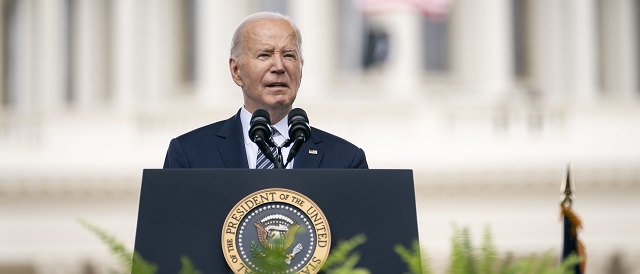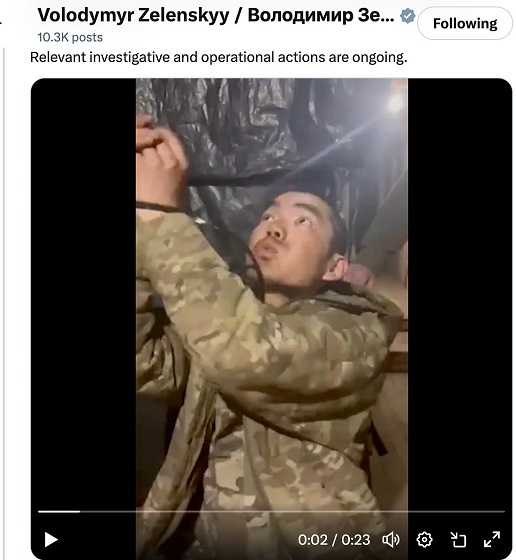conflict
Slowly But Surely, Biden And The West Are Ramping Up Involvement In Russia-Ukraine War

 From the Daily Caller News Foundation
From the Daily Caller News Foundation
By JAKE SMITH
If we said, ‘Yeah, okay, go ahead [and fire into Russian territory],’ then you’re really putting the Russians in a corner to do something to top that, and who knows what that might be.
As Russia’s war against Ukraine drags on, the U.S. and the NATO alliance are increasing their involvement in the conflict, presenting risks for a more direct confrontation with Moscow.
President Joe Biden reportedly gave Ukraine the green light in May to start firing U.S.-provided weapons directly into certain parts of Russian territory, as NATO members consider a similar policy and the possibility of sending trainers to train the Ukrainian military. The new initiatives would represent a shift in NATO’s policy of engagement in the war and could further escalate the proxy conflict with Russia.
The NATO Parliamentary Assembly convened on Monday and urged the alliance to remove a ban currently preventing Ukraine from firing Western weapons directly into Russian territory, echoing calls recently made by NATO Secretary General Jens Stoltenberg and top officials from Britain, Sweden, Latvia, Poland and Lithuania. Kyiv has long requested that it be allowed to fire Western-provided weapons into Russia, with officials bemoaning that the NATO ban has prevented them from effectively countering Russia’s advances.
Secretary of State Antony Blinken Antony Blinken during a press conference on Wednesday did not signal any immediate policy change plans on how Ukraine is allowed to use U.S. weapons against Russia. But Biden has reportedly already given Kyiv permission to fire into Russian territory, according to the Financial Times, which Blinken failed to mention on Wednesday.
“The president recently directed his team to ensure that Ukraine is able to use U.S. weapons for counter-fire purposes in Kharkiv so Ukraine can hit back at Russian forces hitting them or preparing to hit them,” a U.S. official told Politico on Thursday, adding that the administration’s policy stance against long-range strikes inside Russia “has not changed.”
But Moscow has warned that if NATO allows Ukraine to fire their provided weapons into Russian territory, it will escalate the war and potentially drag alliance member nations further into the conflict. Russian President Vladimir Putin said Tuesday that such an action by NATO would represent another escalation that could “lead to serious consequences.”
“Providing Ukraine with the means and the permission to strike deep into Russian territory significantly increases the chances of a direct U.S.-Russian clash, which in turn could lead to the use of nuclear weapons,” George Beebe, former CIA analyst and director of grand strategy at the Quincy Institute, a non-interventionist foreign policy think tank, told the DCNF. Beebe noted that it was unlikely that Russia would utilize tactical nuclear weapons in the interim but instead potentially target American assets such as satellites, creating “a cycle of tit-for-tat retaliation with the United States that proves difficult to manage and contain.”
Even though Ukraine could benefit from using Western weapons to fire against Russia — as its own domestic weapons are not capable of effective, long-range strikes — the West’s hesitation on the matter may have created a “hype” that will invite a Russian retaliatory response, Jim Townsend, an ex-NATO and Pentagon official and senior fellow at the Center for New American Security, a foreign policy think tank led by former Democrat officials, told the DCNF.
“We have made this such a big deal that it will force the Russians to react one way or another. All of a sudden, it has become a red line drawn by the Russians, highlighted by the U.S. not wanting to escalate,” Townsend said. “And now, it has got such a high profile publicly that if we said, ‘Yeah, okay, go ahead [and fire into Russian territory],’ then you’re really putting the Russians in a corner to do something to top that, and who knows what that might be. So I think that certainly does run a risk of escalation, even more so than it did earlier in the war.”
Aside from weapons policy, members of the NATO alliance are also considering the idea of sending troops into Ukraine to help train Ukrainian forces. Ukraine suffers from a worsening manpower shortage and is rapidly recruiting and conscripting new men for the war effort; Kyiv has requested the U.S. and NATO to help train them.
A NATO-backed training presence in Ukraine, which would be the first of its kind since the war began, could bolster the country’s fighting abilities against Russia, whose own military does not suffer from the same manpower problems.
But if NATO-allied troops stationed in Ukraine are caught in the crossfire of an attack from Russia, it could prompt the entire alliance to take much more direct action in the conflict. Article Five of the NATO treaty stipulates that “an armed attack against one or more of them in Europe or North America shall be considered an attack against them all” and the alliance is then obligated to collectively take “action as it deems necessary,” including through armed force.
“Let’s say there are French trainers or German trainers in Ukraine, and they’re killed in a Russian missile strike,” Michael DiMino, a senior fellow at Defense Priorities and former CIA official, told the DCNF. “So now, what do we do? What happens after that? Do we go ahead and avenge those casualties and have the U.S. or France or Germany — again, all NATO members — engaged in some kind of limited strike on Russia? Is Russia not going to view that as an act of war and then not respond?”
If NATO troops are killed in a Russian attack and the alliance chooses not to pursue retaliation, it could come with the risk of undermining the alliance’s promise to defend itself.
“Even relatively small numbers of Western boots on the ground would create an enormous incentive for Russia to target them; failure to do so would only encourage the West to believe that Russia would tolerate greater and greater direct Western involvement over time,” Beebe told the DCNF.
Kyiv officials and Zelenskyy will attend a June peace summit in Sweden “to provide a forum where world leaders discuss paths towards a just and lasting peace in Ukraine; over 160 countries have been invited, including the U.S., although Biden has not signaled that he will be in attendance. Kyiv will also have a presence at the annual NATO summit in July, where, among other issues, existing and new initiatives to bolster Ukraine’s security will be discussed, potentially including sending troops to the region and lifting Western weapons use restrictions.
Featured image: WASHINGTON (May 15, 2024) US President, Joe Biden, delivers remarks during the 42nd Annual National Peace Officers’ Memorial at the US Capitol in Washington, DC. (DHS photo by Tia Dufour)
conflict
Zelensky Alleges Chinese Nationals Fighting for Russia, Calls for Global Response

 Sam Cooper
Sam Cooper
Ukrainian President Volodymyr Zelensky announced Tuesday that his forces have captured two Chinese citizens fighting as part of the Russian army in eastern Ukraine, alleging “there are many more Chinese citizens in the occupier’s units.” The stunning revelation could inject a volatile new dimension into ceasefire negotiations between the United States and Russia—and intensify already fraught tensions over Taiwan.
Zelensky shared the news in an X post, accompanied by video of one of the captured men—an Asian male in beige fatigues, hands bound with zip ties, visibly distressed as he gestures to a Ukrainian camera operator. The video shows the man making whirring sounds, crouching instinctively as if a drone is circling above and opening fire—then glancing up and uttering the English word, “commander.”
“We have information suggesting that there are many more Chinese citizens in the occupier’s units than just these two,” Zelensky wrote on X. “We are currently verifying all the facts—intelligence, the Security Service of Ukraine, and the relevant units of the Armed Forces are working on it.”
The president said he has instructed Ukraine’s foreign minister to urgently contact Beijing to clarify how China intends to respond.
“Russia’s involvement of China, along with other countries, whether directly or indirectly, in this war in Europe is a clear signal that Putin intends to do anything but end the war,” Zelensky wrote. “He is looking for ways to continue fighting. This definitely requires a response. A response from the United States, Europe, and all those around the world who want peace.”
Zelensky added that Ukrainian authorities had recovered documents, bank cards, and personal data from the two prisoners—material that could be pivotal in discovering the nature of China’s involvement.
If verified, the presence of Chinese nationals fighting for Russia could carry sweeping geopolitical implications. It would complicate delicate U.S.-Russia negotiations aimed at exploring a conditional ceasefire, and could have indirect ramifications on the plans of Washington, Tokyo, and Taipei in their growing confrontation with Beijing.
China has repeatedly denied providing direct military support to Russia. Zelensky’s statement marks the first time Ukraine has publicly alleged that Chinese nationals are embedded in Russian combat units—an allegation that, if substantiated, could alter the strategic calculus in both Eastern Europe and the Indo-Pacific.
Responding to Zelensky’s claims, Tom Shugart, a senior defense analyst at the Center for a New American Security and a former U.S. Navy officer, emphasized that the strategic implications hinge on whether the Chinese nationals were acting as mercenaries or state-directed personnel. “If the PRC is actively providing soldiers to fight in Ukraine, that would be altogether different—a possible sign of a real Axis that may best be resisted wherever it is fighting,” he wrote on X.
This is a developing story. The Bureau will continue to report as further details emerge.

Recommend The Bureau to your readers
conflict
“HELL WILL RAIN DOWN”: Trump unleashes U.S. military on Yemeni Houthis

 MxM News
MxM News
Quick Hit:
President Trump ordered a massive military assault on Iranian-backed Houthi forces in Yemen on Saturday, vowing to unleash “overwhelming lethal force” after months of attacks on American and allied vessels in the Red Sea.
Key Details:
-
Trump announced the strikes in a Truth Social post, stating, “Today, I have ordered the United States Military to launch decisive and powerful Military action against the Houthi terrorists in Yemen.”
-
He criticized former President Joe Biden for failing to contain the Houthis, saying his response was “pathetically weak” and emboldened the group’s ongoing attacks on commercial and military vessels.
-
The U.S. Navy’s USS Harry S. Truman carrier strike group, along with three destroyers and a cruiser, launched the assault, targeting radars, air defenses, and missile systems used to disrupt shipping lanes.
CENTCOM Forces Launch Large Scale Operation Against Iran-Backed Houthis in Yemen
On March 15, U.S. Central Command initiated a series of operations consisting of precision strikes against Iran-backed Houthi targets across Yemen to defend American interests, deter enemies, and… pic.twitter.com/u5yx8WneoG
— U.S. Central Command (@CENTCOM) March 15, 2025
Diving Deeper:
President Trump escalated U.S. military action against Iran-backed Houthi rebels on Saturday, ordering airstrikes on targets in Yemen in response to the group’s repeated attacks on Red Sea shipping. Trump, in a Truth Social post, declared that the U.S. military would not tolerate continued aggression and vowed an overwhelming response.
“The Houthi attack on American vessels will not be tolerated,” Trump wrote. “We will use overwhelming lethal force until we have achieved our objective.” He directly warned the Houthis, stating, “YOUR TIME IS UP, AND YOUR ATTACKS MUST STOP, STARTING TODAY. IF THEY DON’T, HELL WILL RAIN DOWN UPON YOU LIKE NOTHING YOU HAVE EVER SEEN BEFORE!”
The strikes, carried out by U.S. Central Command, targeted missile sites, drone launch facilities, and command centers used by the Houthis to strike commercial and military vessels in the Red Sea. U.S. warships and carrier-based fighter jets participated in the mission, marking a significant escalation in efforts to protect international shipping routes.
Trump also issued a direct warning to Iran, demanding that its support for the Houthis “must end immediately.” Addressing Tehran, Trump wrote, “Do NOT threaten the American People, their President…or Worldwide shipping lanes. If you do, BEWARE, because America will hold you fully accountable and we won’t be nice about it!”
The strikes come after more than a year of escalating attacks by the Houthis, who have targeted over 100 merchant vessels, sunk at least two, and killed multiple sailors since the Israel-Hamas war began. Trump pointed to Biden’s failures in handling the crisis, noting that “it has been over a year since a U.S.-flagged commercial ship safely sailed through the Suez Canal, the Red Sea, or the Gulf of Aden.”
With Trump’s order, the U.S. is making clear that hostile actions in the Red Sea will not go unanswered. As military operations continue, all eyes will be on whether the Houthis and their Iranian backers heed the warning—or face even greater firepower from the U.S. military.
-

 2025 Federal Election1 day ago
2025 Federal Election1 day agoOttawa Confirms China interfering with 2025 federal election: Beijing Seeks to Block Joe Tay’s Election
-

 Energy2 days ago
Energy2 days agoIndigenous-led Projects Hold Key To Canada’s Energy Future
-

 2025 Federal Election1 day ago
2025 Federal Election1 day agoHow Canada’s Mainstream Media Lost the Public Trust
-

 Energy2 days ago
Energy2 days agoMany Canadians—and many Albertans—live in energy poverty
-

 2025 Federal Election14 hours ago
2025 Federal Election14 hours agoBREAKING: THE FEDERAL BRIEF THAT SHOULD SINK CARNEY
-

 Business2 days ago
Business2 days agoCanada Urgently Needs A Watchdog For Government Waste
-

 2025 Federal Election1 day ago
2025 Federal Election1 day agoReal Homes vs. Modular Shoeboxes: The Housing Battle Between Poilievre and Carney
-

 2025 Federal Election15 hours ago
2025 Federal Election15 hours agoCHINESE ELECTION THREAT WARNING: Conservative Candidate Joe Tay Paused Public Campaign






